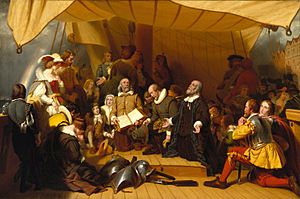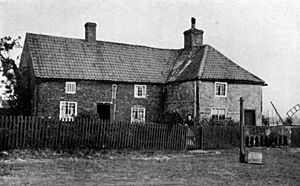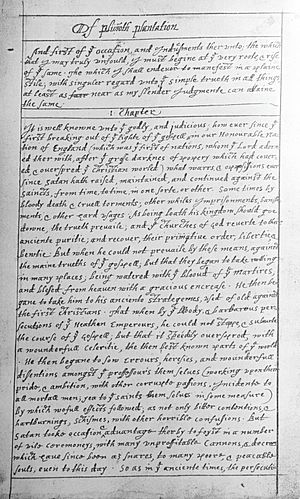William Bradford (Mayflower passenger) facts for kids
William Bradford (1590–1657) was an important leader in early American history. He sailed on the famous ship Mayflower in 1620. He traveled to the New World to find a place where people could worship freely.
Bradford became the second Governor of Plymouth Colony. He served for more than 30 years. He also wrote a detailed journal called Of Plymouth Plantation. This journal tells the story of the early days of Plymouth Colony. It is a very important historical record.
Contents
Early Life in England
William Bradford was born in Austerfield, Yorkshire, England. His family were farmers and owned a large farm. They were considered wealthy for their time.
Bradford's father died when William was only one year old. At age four, he went to live with his grandfather. Two years later, his grandfather also died. William then returned to live with his mother and stepfather. Sadly, his mother died in 1597 when he was seven. William became an orphan and went to live with two uncles.
His uncles wanted William to help on the farm. But William was often ill and could not do much farm work. Instead, he spent his time reading many books. One of these books was the Bible. This is likely where he began to learn about a religion different from the official Church of England.
When William was 12, he went with a friend to hear Pastor Richard Clyfton speak. Clyfton was a minister who did not agree with the Church of England. William believed in Clyfton’s message. His uncles told him not to go to that church, but he went anyway.
During one meeting, he became friends with William Brewster. Brewster lived nearby. William borrowed books from him about this new church.
Seeking Religious Freedom
King James I of England began to punish people who did not follow the Church of England. These people were called Separatists. By 1607, many Separatists were arrested. Brewster had to pay a fine for attending the church. Some members were put in prison, and others were watched closely. The Separatists also heard that others in London had been imprisoned and left to starve.
The Separatists decided to leave England. They planned to go to the Dutch Republic (modern-day Netherlands), where religious freedom was allowed. William Bradford joined them. Leaving England without permission was illegal. The group was betrayed by an English sea captain. He turned them over to the English authorities. Most of the congregation, including Bradford, were put in prison. By the summer of 1608, the Separatists, and William Bradford, managed to escape to Leiden, Netherlands. Bradford was 18 years old.
Life in the Dutch Republic

William Bradford first moved to Amsterdam in August 1608. He lived with the Brewsters. The Separatists had spent most of their money leaving England, so they were poor. After nine months, the group moved to the smaller city of Leiden.
When Bradford turned 21, he received some money. He used it to buy his own house. He also built a workshop and worked as a weaver. People liked him.
In 1613, Bradford married Dorothy May. She was the daughter of a wealthy English couple living in Amsterdam. In 1617, the Bradfords had their first child, John Bradford.
By 1617, the Separatists decided to travel to Virginia Colony in North America. Even though they could practice their religion in the Dutch Republic, they wanted their children to keep their English customs and language. The colonists made a deal with the Merchant Adventurers. This was a group of men who paid for the Pilgrims' journey to the New World. In return, the Pilgrims promised to pay them back with furs and other goods from the colony. By July 1620, Robert Cushman and John Carver had made the plans. Fifty Separatists left Delftshaven on the ship Speedwell.
Many families were separated. Some Separatists stayed in the Netherlands. They planned to travel to the New World after the colony was set up. William and Dorothy Bradford left their three-year-old son John with Dorothy's parents in Amsterdam. Perhaps he was too young or weak for the long journey.
The Journey Begins
The Speedwell was supposed to meet the Mayflower. Both ships would then travel to Virginia Colony. However, the Speedwell was not safe. Its passengers had to move onto the Mayflower. This made the ship very crowded. Not all the passengers were Separatists. About 50 colonists joined because they had useful skills. These skills would be important on the Mayflower and in the new colony. Bradford wrote that they hugged and cried, saying goodbye to family and friends for the last time. He said they knew they were pilgrims and looked to heaven, their "dearest country," which comforted them.
The Mayflower Voyage
The Mayflower left Plymouth, England, on September 16, 1620. There were 102 passengers and 30–40 crew members. On November 19, 1620, the Mayflower spotted land. The ship was supposed to land in Virginia Colony. But it was too damaged, so they had to land at Cape Cod, now called Provincetown Harbor.
They landed on November 21. Before leaving the ship, they wrote the Mayflower Compact. This document created rules for how they would live and treat each other. William Bradford signed the Mayflower Compact.
Exploring Plymouth Colony
At 30 years old, Bradford had not yet been a leader in the colony. After the Mayflower anchored, the men went to explore the land. They needed to find a good place to live. Bradford volunteered to join these exploration parties. In November and December, these groups went out three times, both on foot and by boat.
One early exploration group included William Bradford, John Carver, Myles Standish, Edward Winslow, John Howland, and others. Of this group, Stephen Hopkins was the most experienced. He had seen Indians during his time in Jamestown, Virginia. Bradford wrote that they set off in freezing weather. Many men were already sick. He said the salt spray froze on their coats, "as if they had been glazed." During their trip, they saw Indians who seemed to be cutting up a large whale. When the Indians saw the men, they ran away. The men camped and protected themselves from the cold and from any possible danger.
They found the location that would become Plymouth Colony in December. During the first trip on foot, Bradford was caught in a deer trap made by Native Americans. He was hung upside down! During the third exploration, on December 6, 1620, Bradford and the other men found Plymouth Bay. A winter storm almost sank their boat as they neared the bay. The explorers were very cold and started to get sick. The waves were high, but they landed on Clark's Island.
During this time, they searched areas around the bay. They found a good place to live and build their homes. The spot had a large hill, now called Burial Hill. This hill was a good place to build a fort for safety. There were also many brooks providing fresh water. They later learned that the site had been a Native American village called Patuxet. This is why a large area was already cleared for planting food. The Patuxet tribe had all died from a terrible sickness between 1616 and 1619. Bradford later wrote that bones of the dead were easy to find in many places.
Life in Plymouth Colony
The Great Sickness
The Mayflower arrived in Plymouth Bay on December 20, 1620. The settlers began building the colony's first house on December 25.
On January 11, 1621, Bradford was helping to build houses when he felt a sharp pain in his hipbone and fell. He was taken to the "common house" (the only finished house). They thought he would die that night, but he survived.
Bradford recovered, but many other Pilgrims were not so lucky. During February and March 1621, sometimes two or three people died every day. By the end of the winter, half of the 100 settlers had died. They buried their dead in secret. They did this so the Native Americans would not see how many were dying. They buried them in Cole's Hill and tried to hide the graves from animals.
Only a few men remained healthy. Everyone, including the children, had to work and care for the sick. One of these healthy men was Captain Myles Standish. He was a soldier hired by the settlers to protect the colony. Standish cared for Bradford during his illness, and they became good friends. Bradford had no military experience. When he became governor, he relied on Captain Standish's advice for military matters.
William Bradford was chosen by the people to be Governor of Plymouth Colony. He kept detailed journals, which are very important even today. They are the only history of how the Mayflower passengers and their families lived in Plymouth Colony. He died before he could finish the second book of his journal.
Early Years as Governor
On March 16, the settlers had their first meeting with the Native Americans who lived in the region. Samoset, an Indian, walked into Plymouth village and greeted them in English. Samoset had learned some English from traders who had visited his area. This soon led to a visit by Massasoit, the leader of the Pokanoket tribe. At that meeting, Massasoit made a treaty with Governor John Carver. The treaty stated that they would be friends and protect each other from unfriendly Indians.
Bradford wrote down what was said. He would soon become governor, and this treaty, promising mutual help, was very important. This agreement was not liked by Massasoit's enemies in other tribes.
In April 1621, Governor Carver became sick while working in the fields on a hot day. He died a few days later. The settlers of Plymouth then chose Bradford as their new governor. Bradford would remain governor for most of his life.
The elected leadership of Plymouth Colony first included a governor and an assistant governor. For the first three years, Isaac Allerton was the assistant governor. In 1624, the system changed to five assistants. This group was called the "governor's council." These men gave advice to the governor and had a vote on important matters. They helped Bradford manage the Colony. Early assistants included Thomas Prence, Stephen Hopkins, John Alden, and John Howland.
Family Life
William Bradford married Dorothy May in Amsterdam, Holland, on December 10, 1613. They had one son, John. Sadly, Dorothy fell from the deck of the Mayflower into the water and drowned shortly after the ship landed. Her husband was away on an exploring mission at the time. John was born in Leiden, Holland.
His second wife was Alice Southworth. They married in Plymouth and had three children together. Alice died in Plymouth in March 1670 and was buried on Burial Hill in Plymouth, near her husband.
William Bradford's Writings
Bradford wrote Of Plymouth Plantation. It was a history about Plymouth Colony. It is often called a journal. It was a collection of what he saw and what he thought was important. This was written in two books. The first book was written in 1630, but the second was never fully finished. Between 1646 and 1650, he wrote about the colony's history up to 1646.
In Of Plymouth Plantation, Bradford saw events happening in a way similar to stories in the Bible. As Philip Gould writes, "Bradford hoped to show the workings of God to future generations." The book was published in 1656, the year before his death, and it was very popular. Bradford has been called the "father of American history." Many American authors have used what Bradford wrote in their own books. Thomas Prence did so in his book A Chronological History of New-England in the Form of Annals. Today, Bradford's journal is considered very important. It is studied in American schools and colleges. Parts of Bradford's journal were also included in another work called Mourt's Relation. This book was partly written by Edward Winslow and published in England in 1622.
Images for kids
-
Signing the Mayflower Compact 1620, a painting by Jean Leon Gerome Ferris 1899
-
Provincetown, Massachusetts memorial to Pilgrims who died at sea or on board the Mayflower in Cape Cod Harbor in November/December 1620
See also
 In Spanish: William Bradford para niños
In Spanish: William Bradford para niños






